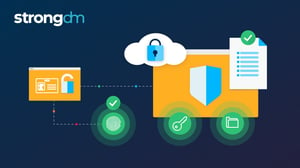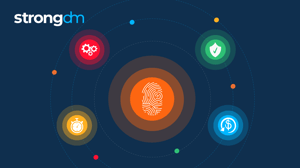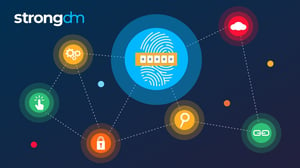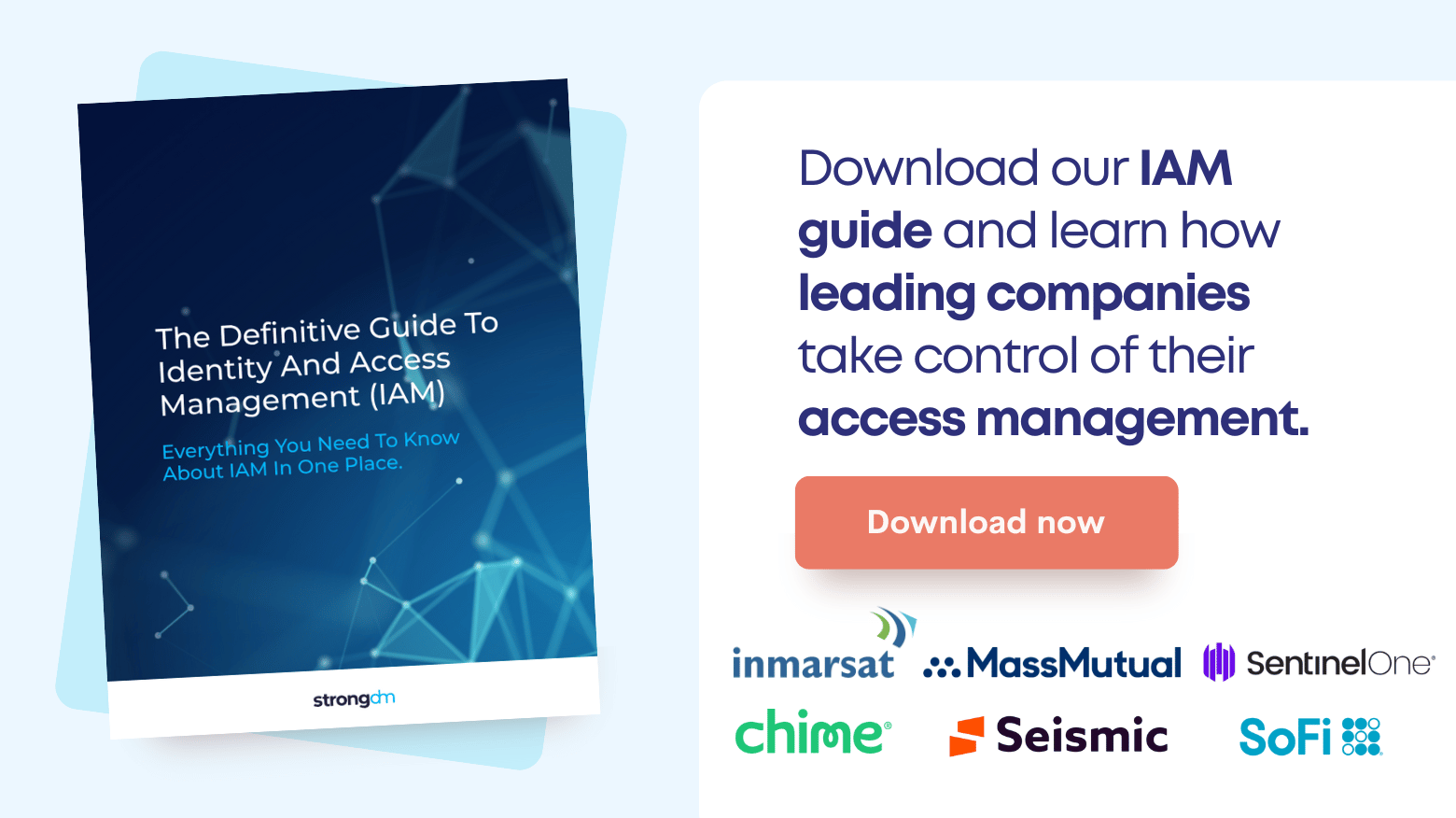Top 7 Identity and Access Management (IAM) Solutions in 2026
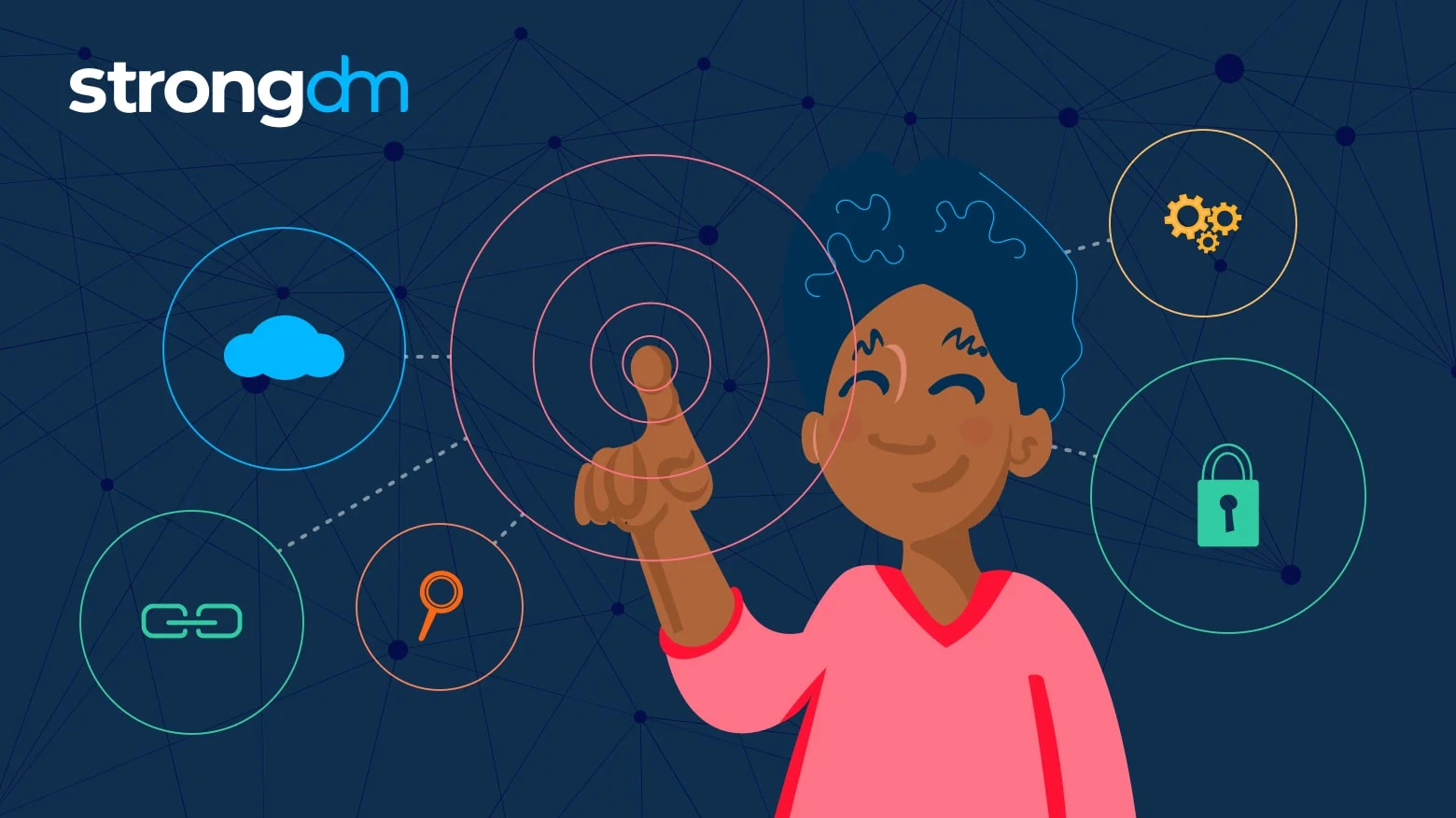

Written by
John MartinezLast updated on:
October 17, 2025Reading time:
Contents
Built for Security. Loved by Devs.
- Free Trial — No Credit Card Needed
- Full Access to All Features
- Trusted by the Fortune 100, early startups, and everyone in between
Summary: In this article, we’ll review the leading IAM solutions and tools on the market. We’ll explore what business needs identity and access management solutions address and review the pros and cons of each. By the end of this article, you’ll know how to choose the right IAM solution for your organization.
1. StrongDM
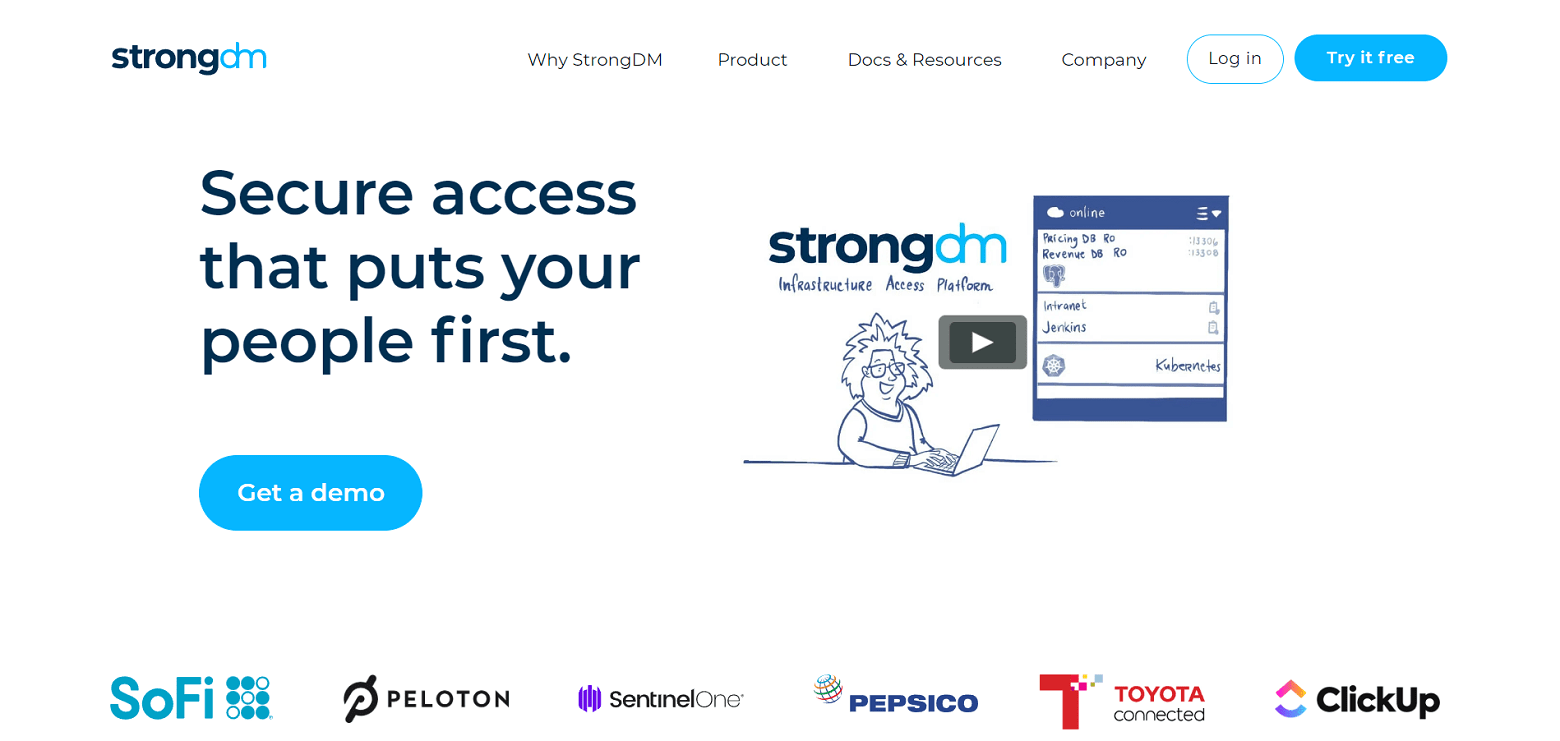
Consistently rated as one of the best IAM solutions, StrongDM is easy to deploy and makes identity access management simple and accessible. StrongDM’s user-friendly platform helps enterprises streamline authentication, authorization, and networking. It also provides secure access management and visibility across the entire IT infrastructure via a centralized control pane.
StrongDM’s IAM software integrates seamlessly with any existing tech stack—including other IAM tools like single sign-on (SSO) solutions, SIEMS, and more. It eliminates point solutions and manages access across all databases, servers, Kubernetes clusters, and applications. It also simplifies monitoring and maintains detailed query, web, and activity logs with session replays available for easy reporting and auditing.
With StrongDM, it’s easy to align user permissions with corporate security policies and procedures. Plus, enterprises can automate access management tasks, which saves time, money, and IT resources.
StrongDM pros
- Simplifies onboarding, eliminating the need to provision database credentials, SSH keys, or VPN passwords
- Provides secure off-boarding, automatically revoking all access
- Adopts security best practices: least privilege, ephemeral permissions, and audit trails
- Logs every permission change, database query, SSH, and kubectl command
- Compatible with any SQL client, CLI, or desktop BI tool
StrongDM cons
- Requires continuous access to StrongDM API for access to managed resources
Learn more about StrongDM's competitors and alternatives.
2. CyberArk Identity
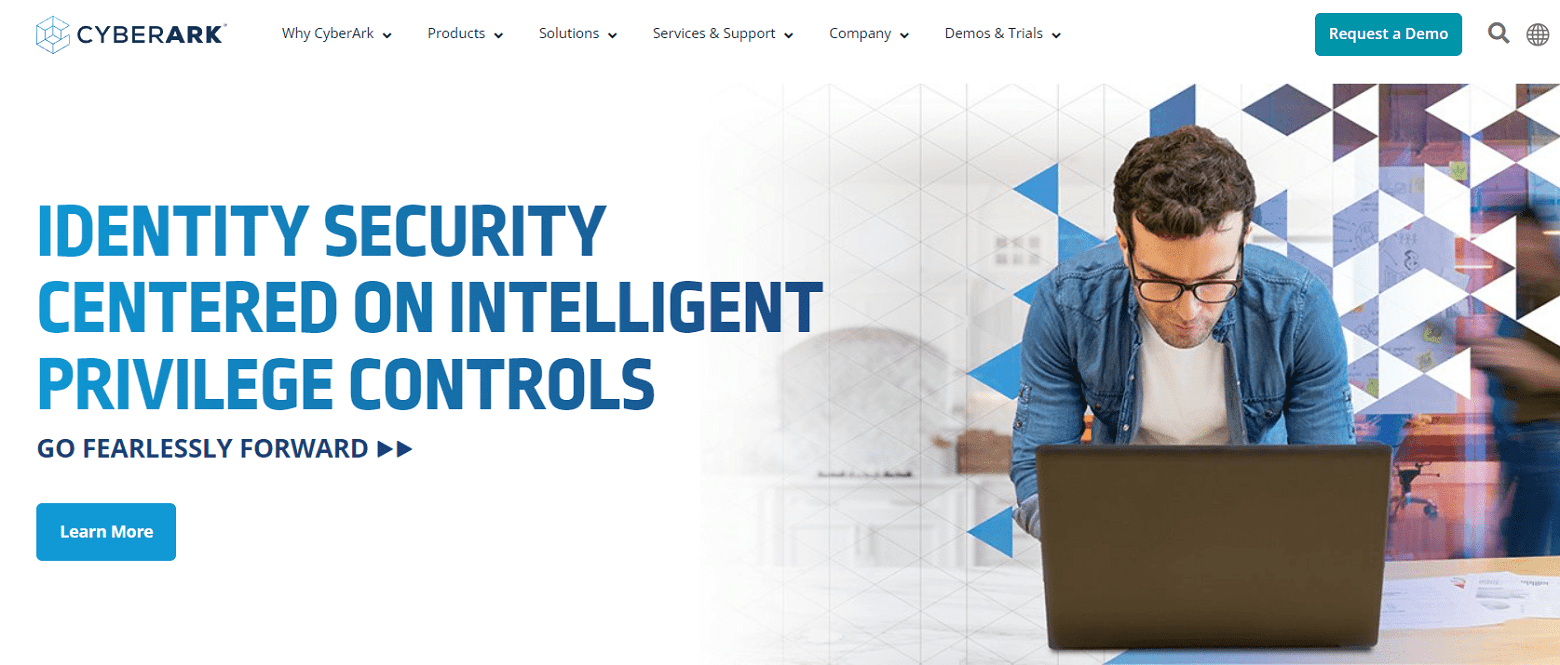
The CyberArk Identity Security Platform, formerly known as Idaptive, is a SaaS-delivered suite of solutions that combines workforce access and identity management. CyberArk Identity simplifies access management; automates onboarding and offboarding; and provides lifecycle management, identity orchestration, and Identity Governance and Administration (IGA).
CyberArk’s SSO uses browser extensions to recognize credentials, providing a frictionless experience for cloud, mobile, and legacy applications. Multi-factor authentication (MFA) leverages machine learning to profile behavior and detect anomalies. An extensive API library supports over 150 integrations. CyberArk simplifies operations via a single portal, offers unified auditing to streamline compliance, and provides continuous threat detection and protection.
CyberArk Identity pros
- Extends protection to endpoints, ensuring only approved devices connect to a network
- Offers a recording feature that performs process isolation and reauthentication for high-risk sessions
- Includes customer identity access management (CIAM) developer tools
- One of the oldest identity and access management vendors
CyberArk Identity cons
- User interface is difficult to navigate
- CyberArk has significantly higher pricing than other identity and access management companies
- Complex deployment and below-average developer tools
- No support for progressive profiling or granular consent management
- Heavy API programming requirements
Learn more about CyberArk's competitors and alternatives.
3. Okta
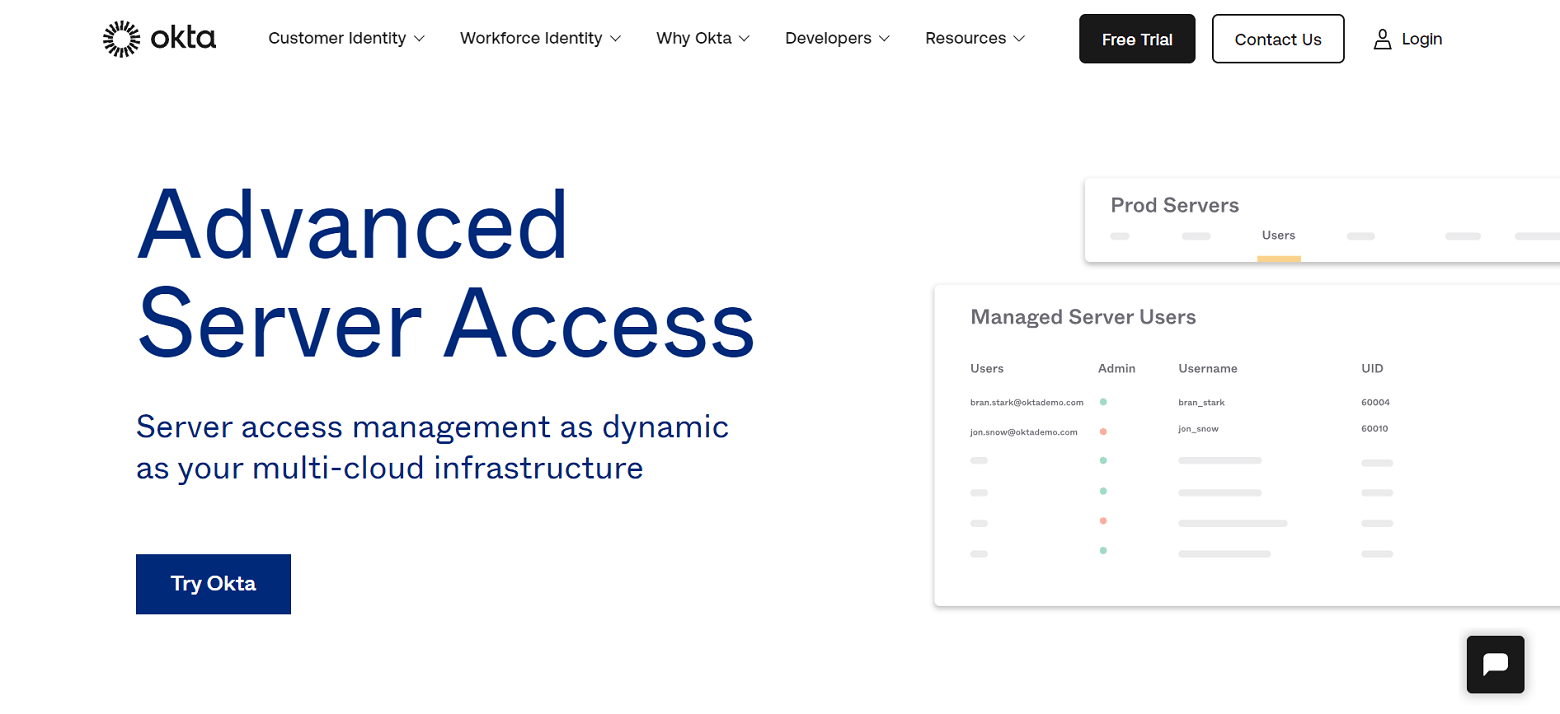
Acquiring Auth0 in 2021 has made Okta a strong competitor among the top enterprise IAM solutions providers. Okta delivers its workforce-focused platform (Okta Identity Cloud) and its developer-focused identity platform (Auth0) as SaaS products. Okta Identity Cloud is a cloud-based IAM solution that helps enterprises secure and manage their entire IT infrastructure, whether on-premises or in a private, public, or hybrid cloud.
Built on Zero Trust principles, Okta Identity Cloud provides SSO, MFA, password management, passwordless security, analytics, and robust data security to prevent SQL injections, cross-site scripting, and forgery requests. Its extensive API library integrates with myriad popular applications, including Zoom, Slack, and Salesforce. Okta Identity Cloud also includes features to manage IGA.
Okta pros
- Highly competitive set of IAM tools with a solid reputation for reliability and availability
- Intuitive and easy to deploy
- Secure back-end support for APIs and easy integration with a wide range of applications
- Rich feature set with extensive workflow and developer tools
Okta cons
- Requires software running on every server it manages access to
- CLI-only client scares off non-engineers
- Audit logs only cover SSH
- Higher than average pricing makes it less accessible to small businesses
- Confusing to choose between two cloud IAM solutions
Learn more about Okta's competitors and alternatives.
4. BeyondTrust
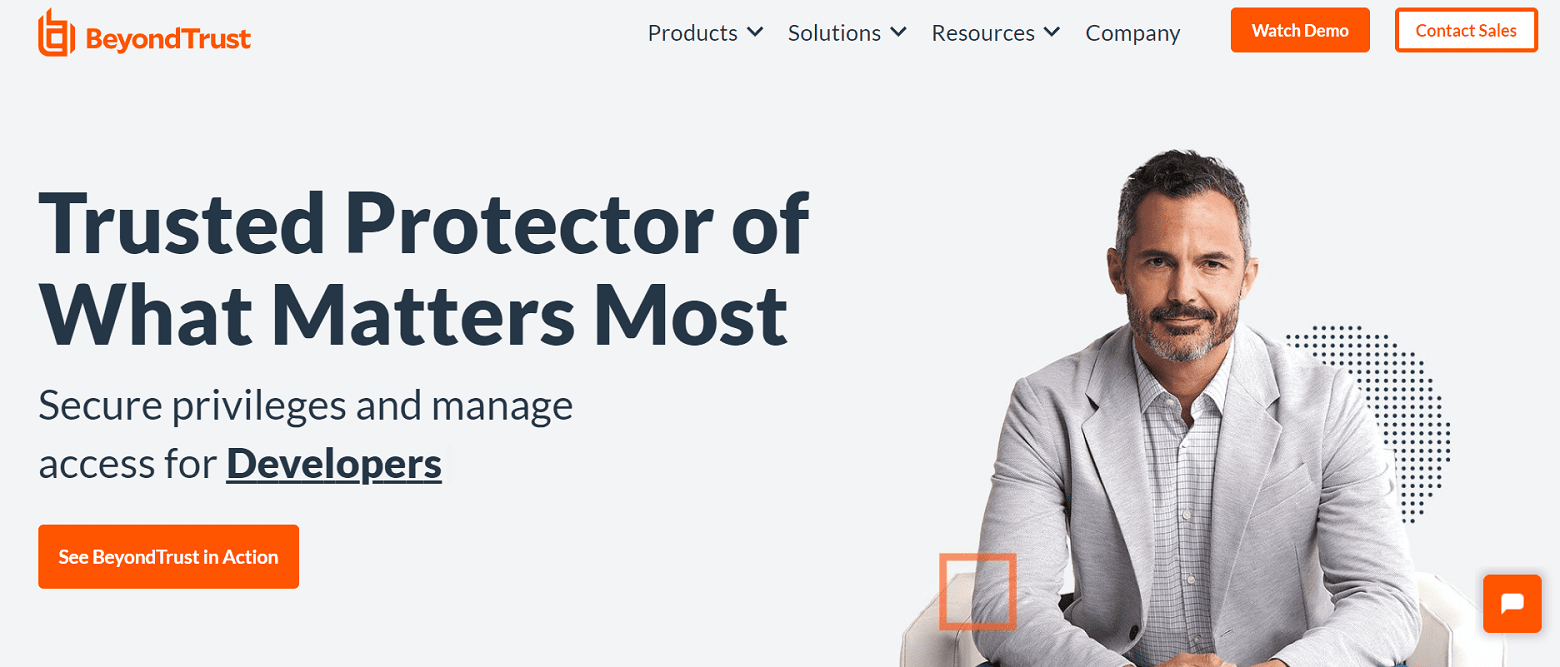
BeyondTrust offers a suite of identity and access management tools for approving and revoking user access to critical systems and monitoring activity across a wide range of platforms and devices, including Linux, Windows, Mac, UNIX, and other mobile and cloud apps. BeyondTrust extends the benefits of privileged access management (PAM) to network and cloud environments while eliminating the need for a VPN.
This product suite provides endpoint security and centralized secrets management; secure storage and auditing for privileged account credentials; and remote monitoring, access, and control for all devices regardless of location.
BeyondTrust’s identity and access management solution maintains a video log for auditing user behavior, includes analytics to assist in investigations, and integrates seamlessly with external directories, such as LDAP.
BeyondTrust pros
- Supports SSH and RDP protocols
- Supports least privilege access for Unix and Linux servers and Windows and macOS
- Supports authentication with AD, LDAPS, RADIUS, and Kerberos
- Includes REST APIs and CLI tools to streamline development workflows and allow seamless API integrations
- Established in the endpoint security industry since 1985
BeyondTrust cons
- No secure way to manage access to databases, Kubernetes clusters, and other internal web applications
- Complex initial setup
- License add-ons cost extra
- High licensing fees compared to other IAM providers
Learn more about BeyondTrust's competitors and alternatives.
5. ManageEngine AD360
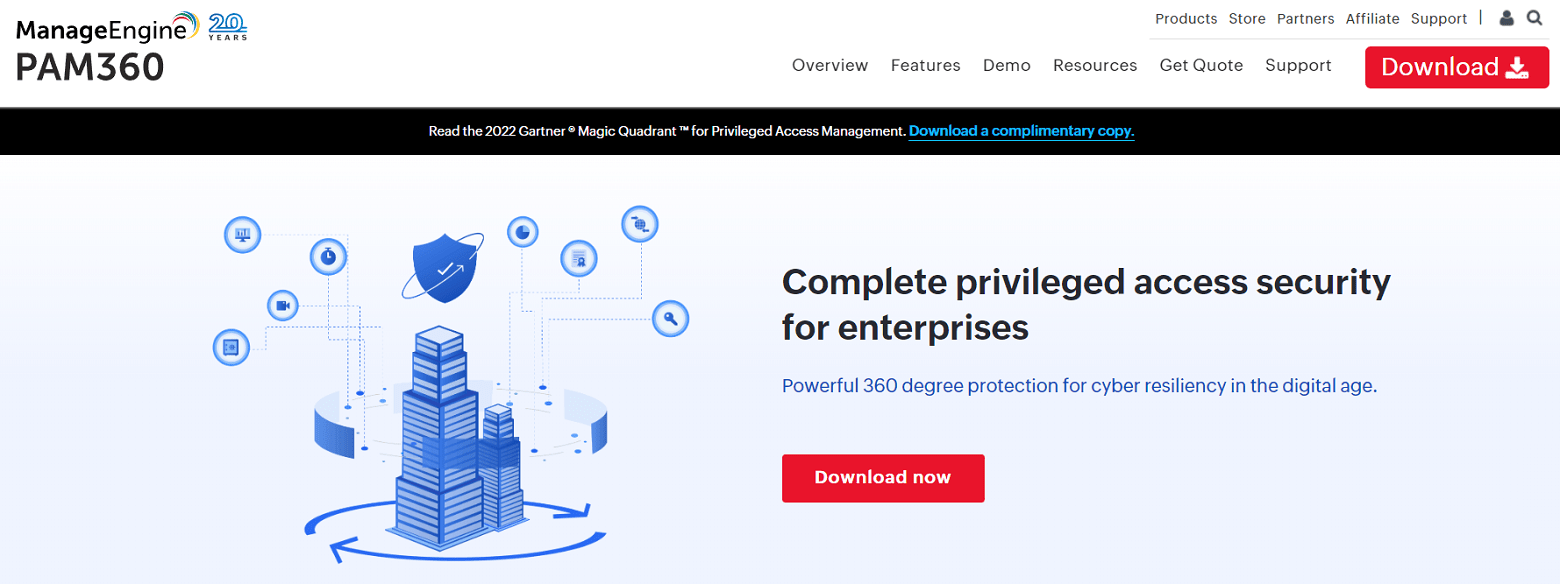
ManageEngine AD360 is one of the best identity and access management solutions for Windows Active Directory environments. It provides a broad range of IAM tools on a single console, including 360-degree user provisioning; user behavior analytics; AI-driven access insights; anomaly detection; SSO with self-service password resets; and MFA for VPNs, OWA, cloud applications, and endpoints.
It’s easy to provision and deprovision user accounts and mailboxes in a single operation across multiple platforms and services. Behavior analytics tools help prevent, detect, and remediate anomalies in user behavior. Over 1,000 built-in reports provide data on activities in on-premises and cloud directories and applications, and IT teams can manage identities on-the-fly from within the reports.
ManageEngine AD360 pros
- Offers straightforward installation and easy integration with a wide range of enterprise applications, including HRMS, SIEM, and ITSM
- Supports bulk provisioning through customizable user creation templates or by importing user data in CSV format
- Exports reports in CSV, PDF, HTML, and XLS formats
ManageEngine AD360 cons
- Complicated user interface can be slow
- Modular pricing increases costs significantly
- No solutions for incorporating organizational policies and standards into user password management requirements
Learn more about ManageEngine PAM360's competitors and alternatives.
6. Saviynt
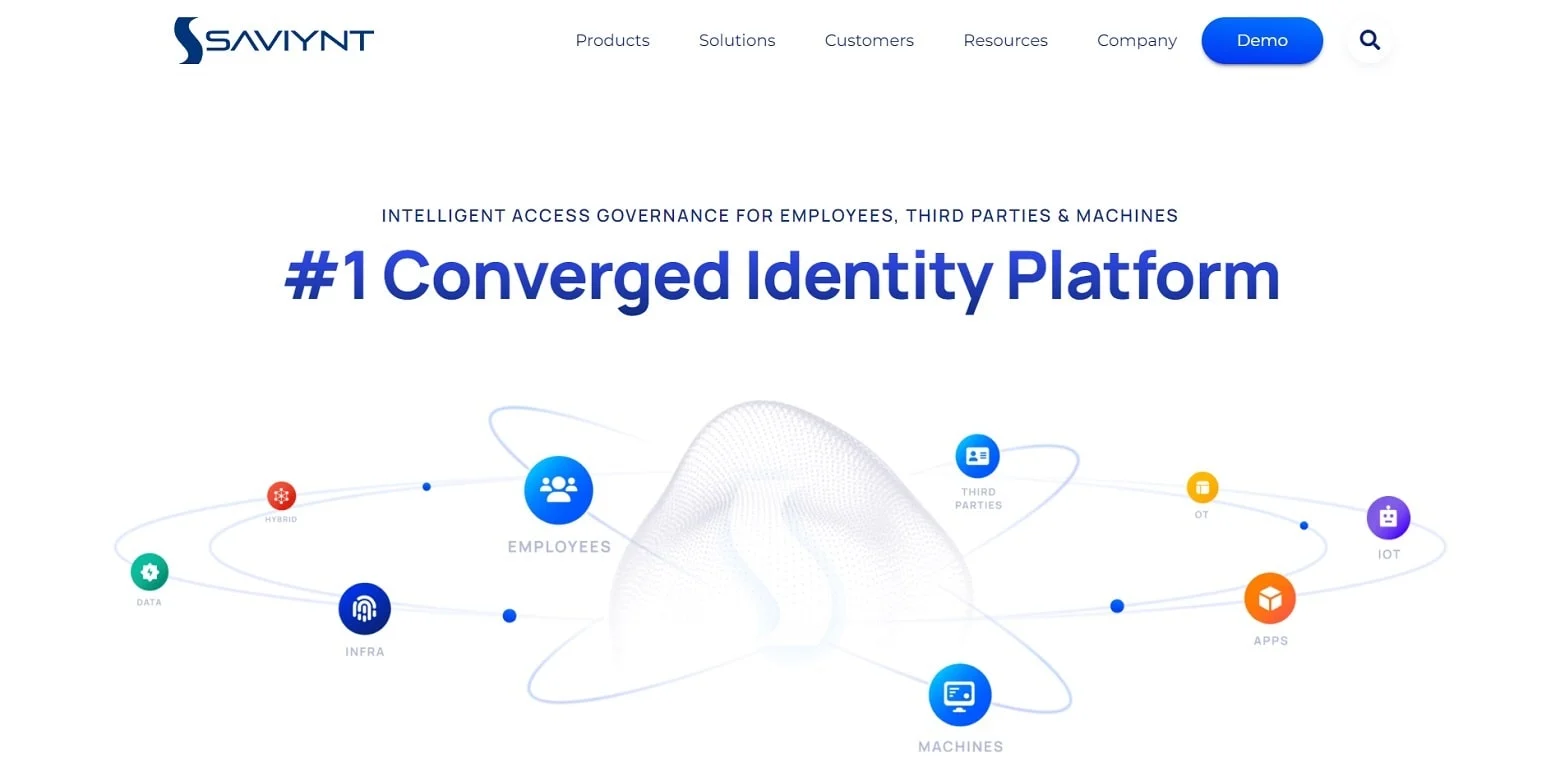
Saviynt’s cloud-native workforce identity and access management software focuses on IGA. For enterprises seeking to transition from legacy IGA systems to the cloud, this product is a solid choice. With Saviynt, organizations can stay in compliance with evolving identity governance standards.
Saviynt takes a Zero Trust approach to identity management and leverages privileged access management (PAM) standards. It helps enterprises mitigate risks across their application ecosystem and simplifies access management through granular access controls for applications.
Saviynt pros
- Provisions users anywhere, anytime, and across any application
- Narrows gaps in access security and uses analytics powered by AI and machine learning to locate identities that introduce risk
- Streamlines detection of unexpected violations and segregation of duty (SoD) conflicts across applications
- Simplifies implementation and offers a user-friendly interface
Saviynt cons
- Limited integration capability
- Does not support customizations
- Limits the number of logs users can access per 24-hour period
- Poor performance when processing data across applications
- Costly licensing compared to other IAM products
Learn more about Saviynt's competitors and alternatives.
7. Twingate
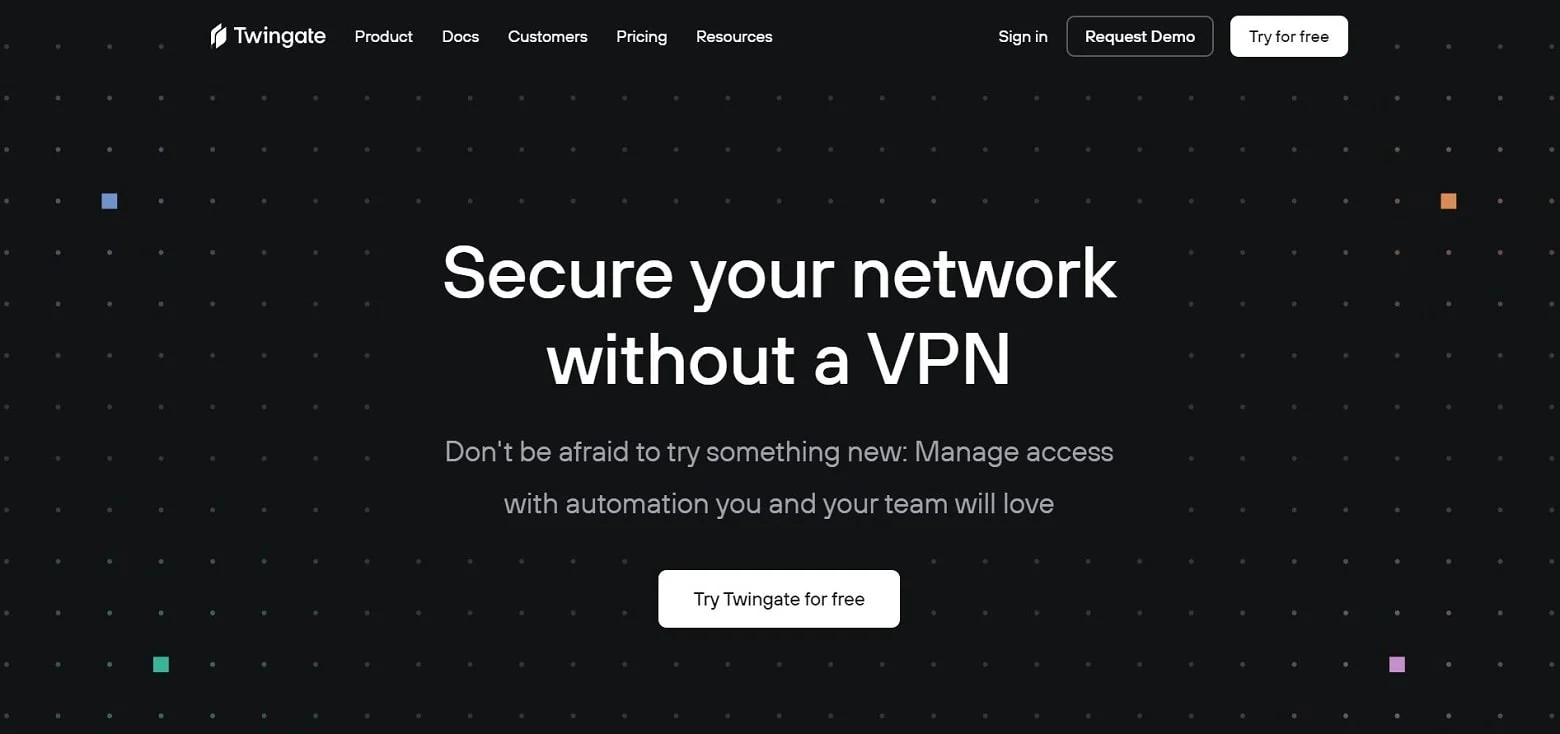
Twingate offers a cloud-based IAM solution for companies seeking to avoid the security and performance problems associated with Virtual Private Networks (VPNs). Twingate replaces traditional VPNs, providing a secure remote access solution built on Zero Trust principles.
Unlike VPNs, Twingate takes a simplified approach to traffic segregation. It provides detailed audit logging, identifies and blocks irregular access patterns, and adds a layer of security. Twingate is ideal for managing access for vendors and contractors and in staging and development environments.
Twingate pros
- Delivers Zero Trust network access
- Integrates easily with SSO providers
- Simplifies change management for IT teams
- Provides real-time connection logs
- Can be implemented quickly
Twingate cons
- Less than ideal for managing access to databases, Kubernetes clusters, cloud CLIs, switches, routers, or internal web applications
- Tiered pricing choices can be overwhelming
- Detailed auditing feature is limited to the Enterprise tier
Learn more about Twingate's competitors and alternatives.
How to Choose the Right IAM Solution
With cloud adoption growing at a breakneck pace, cyberattacks are becoming increasingly common and sophisticated. For example, identity-related fraud nearly doubled between 2020 and 2021. To mitigate risk, modern companies need powerful solutions that simplify identity protection, threat management, and regulatory compliance. This is where the right IAM product can help.
An identity and access management system provides visibility across the entire tech stack, giving organizations a secure way to offer their employees a frustration-free user experience. When choosing between IAM solution providers, look for a reliable tool that fits your budget and is highly secure, and easy to implement, use, and customize.
Get IAM Right with StrongDM
StrongDM shines in many areas where its competitors fall short. There’s no need to settle for an IAM solution that’s too narrow in scope, overly complex, or needlessly difficult to use. Precise control, breadth of integrations, and superior user experience make StrongDM a first-rate choice for organizations that need a high-performance identity and access management system.
Want to learn more? Book a free demo of StrongDM.
Next Steps
StrongDM unifies access management across databases, servers, clusters, and more—for IT, security, and DevOps teams.
- Learn how StrongDM works
- Book a personalized demo
- Start your free StrongDM trial

Categories:

About the Author
John Martinez, Technical Evangelist, has had a long 30+ year career in systems engineering and architecture, but has spent the last 13+ years working on the Cloud, and specifically, Cloud Security. He's currently the Technical Evangelist at StrongDM, taking the message of Zero Trust Privileged Access Management (PAM) to the world. As a practitioner, he architected and created cloud automation, DevOps, and security and compliance solutions at Netflix and Adobe. He worked closely with customers at Evident.io, where he was telling the world about how cloud security should be done at conferences, meetups and customer sessions. Before coming to StrongDM, he lead an innovations and solutions team at Palo Alto Networks, working across many of the company's security products.
You May Also Like

